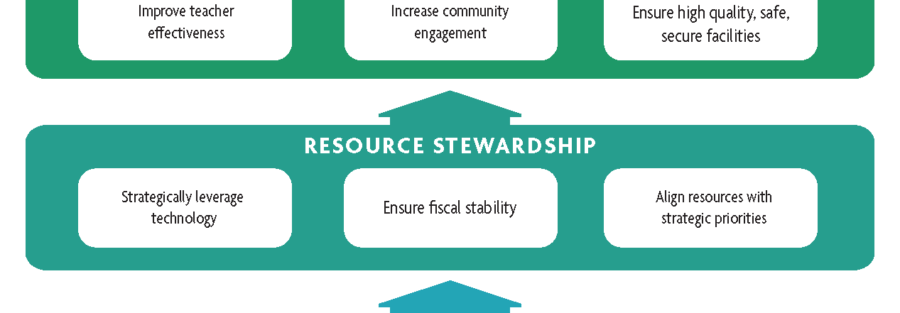The Balanced Scorecard
For a strategy-focused school district, a route for driving systemwide performance measurements, as Atlanta’s experience suggests by

Ten years ago, the Atlanta Public Schools had low and declining student achievement, demoralized teachers, crumbling buildings, high turnover among superintendents (average tenure of two years) and disaffected parents pulling their children out of the system. More than 60 percent of the city’s high school students missed at least two weeks of school per year, and the district had more than 700 teaching vacancies. The system was failing its students and stakeholders.
Fast forward 10 years, and Atlanta has reversed its dismal numbers. Fourth graders’ reading and math scores are nearly on a par with their Georgia peers, chronic absences have plummeted, and 91 percent of the district’s elementary schools made adequate yearly progress in 2009. Last June, the New Schools at Carver had a 94 percent graduation rate. Superintendent Beverly Hall said of the transformation, “Atlanta Public Schools is becoming a model urban school district.”
The difference was not caused by a major infusion of new money, the standard remedy many offer to cure a sick and underperforming school system. Atlanta still has limited resources, constrained operations and multiple, often conflicting, constituencies. The positive developments were brought about by a shift in the district’s leadership and management. Previously, leadership managed reactively, addressing all the short-term operational problems that continually emerged. Today, Hall has the entire district focused simultaneously on delivering short-term results and executing on its long-term strategic plan.
Both of us, Kaplan of Harvard Business School who developed a tool called the balanced scorecard, and Miyake, a consultant who works with education and nonprofit clients to implement processes that improve performance systemwide, have collectively more than 40 years of experience. Miyake worked closely with the Atlanta Public Schools.
A Measuring Stick
All districts do strategic planning. Once a year, they invest time and money to develop a strategic plan and a budget. But for most districts, the strategic plan sits on a shelf until it is dragged out to serve as the starting point for the following year’s annual strategy retreat, an unfortunate, but well-chosen word for this process. The strategic plan is not a living document and has little to no impact on the district’s daily operations.
The poor strategy implementation processes of most school districts, however, are not atypical. Various studies over the past 25 years have documented that 70 to 90 percent of private-sector companies fail to achieve the targets outlined in their multiyear strategic plans. Almost all state that their shortcomings were not due to poor strategies but to their failure to execute their chosen strategies. Surveys indicate that effective strategy execution has become the No. 1 priority for senior executives.
For the transformation led by Hall, the Atlanta Public Schools applied a proven approach that organizations around the world have used to beat the odds against successful strategy execution. The secret is placing strategy as the centerpiece of a dynamic leadership and management system. The system is based on the balanced scorecard, a performance measurement framework developed 20 years ago to address shortcomings in how corporations measure their performance. (The first adoption of the balanced scorecard in a large public school system started in 2001 in Atlanta’s neighboring district, Fulton County.)
The basic principles underlying the balanced scorecard are remarkably simple:
• If you can’t measure it, you can’t manage and improve it; and
• Measurement motivates.
Even with no explicit compensation incentives tied to achieving strategic targets, the simple act of measuring and monitoring causes people to pay attention to what is measured. The power of measurement is well-known and precedes by centuries the introduction of the balanced scorecard.
But prior to the balanced scorecard, performance measurement systems were either purely financial or, at best, driven by local operational improvement and quality programs. They were not derived from nor aligned with the enterprise’s strategy. These disconnects are particular problems for public school systems, where compliance with adequate yearly progress can cause a district to focus only on short-term measures and crowd out measures that align better with long-term strategic objectives.
Hall, recipient of the 2009 National Superintendent of the Year award, described the effort this way: “All school systems focus on student achievement — these are the critical outcomes that we track as educators. But to get to those outcomes, you must measure and evaluate everything we do as a district. The balanced scorecard is our way to look across all departments and ensure they are aligned to our strategy. It gives us transparency and clarity into how our central office (often the target of unfair attacks about a ‘bloated bureaucracy’) supports the district’s progress and children.”
The balanced scorecard captures both the financial and the nonfinancial elements of the strategy and describes the cause-and-effect linkages that drive results. It allows a district to look ahead, with leading indicators, rather than always looking back with lagging indicators.
“Before we adopted the balanced scorecard we had a strategy plan but not a strategy-focused plan,” said Kathy Augustine, Atlanta’s deputy superintendent of curriculum and instruction. “Planning did not compel us to constantly ask questions about alignment and how each department needed to work together so we could meet our goals. The balanced scorecard forced each and every department to answer the critical question: How does my work support the kids?”
Short-term operational measures remain important and AYP metrics and strategic metrics can co-exist successfully as Atlanta has demonstrated. In 2007-08, 100 percent of the district’s 57 elementary schools met targets for adequate yearly progress, while Atlanta continued to execute on its strategic mission of increasing student achievement across the district.
Mapping Strategy
For Atlanta Public Schools, the process of building a balanced scorecard starts by having district leadership clearly articulate linked strategic objectives across the four perspectives of a strategy map for the Atlanta Public Schools.
The linked objectives in the strategy map tell the story of the strategy, indicating the school district will improve student achievement “by focusing on teacher effectiveness, community engagement, and high quality, safe facilities.” It will drive these objectives by “leveraging technology, ensuring fiscal stability and aligning resources with strategic priorities.” This will require “efficient and effective internal processes” and “improvements in customer services.” Finally, to make this happen, the district will “invest in their staff to increase capacity and leadership, increase engagement, improve the recruitment and retention of highly effective staff, and build a culture of alignment and accountability.”
Angela Smith, director of strategic programs and projects, considers the building of the strategy map “a turning point for our curriculum and instruction management team in fully understanding and communicating our strategy. The strategy map is a powerful communication tool that allows us to share and discuss our priorities in one single image. Our strategy map has helped our management team get on the same page.”
Once the strategic objectives have been selected and placed on a strategy map, the district selects one or more measures for each strategic objective. In this way, the district is sure all its metrics can be easily traced back to its strategy. For each metric, the district then selects targets, based on national, state and local performance standards. Then it sets priorities and funds strategic initiatives and the 6- to 18-month action programs that provide the impetus for the district to achieve the ambitious targets for its strategic measures.
This entire system — strategy map, linked measures and targets, and strategic initiatives — focuses and aligns the district to a long-term strategy.
According to Augustine, the balanced scorecard has “accelerated the progress on meeting the superintendent’s plans — from all departments. It’s allowed us to work smarter and in a more integrated fashion. It’s also made the accountability transparent — something that everyone, from funders to parents, is demanding.” Alexis Kirijan, chief strategy officer for Atlanta Public Schools, acknowledges the “excitement around strategic planning” now at the district. Instead of being something that people dread, people actually look forward to the balanced-scorecard reporting process.
Strategy Principles
Over the past 18 years, we’ve learned from many organizations, including Atlanta Public Schools, that have built strategy maps and scorecards. And the biggest learning is that these tools by themselves are not sufficient to drive systemic improvement.
Sharon Davis Williams, executive director of School Reform Team 1 in the district and a champion of the balanced scorecard, realized “it’s not enough to focus just on strategy development — you need to focus instead on strategy implementation.”
The current leadership team in Atlanta Public Schools succeeded where others had failed by implementing a new management system centered around the strategy. The new management system enabled leadership to articulate the cause-and-effect linkages of the strategy, invest to improve the leading indicators of strategic change, motivate all units to focus on the strategy, and govern the system to maintain its trajectory for achieving breakthrough performance.
Five principles characterize this strategy-focused management system.
Five Things We’ve Learned About Organizations
The balanced scorecard is an iterative, learning process. No organization gets everything 100 percent correct the first time. After all, strategy formulation remains an art, not an exact science. It’s our best hypothesis about how organizations will succeed.
• Translate the strategy into operational terms. The strategy map and scorecard translate the district’s strategy into terms that everyone in the organization can understand and act upon. Kirijan’s team owns the responsibility in Atlanta for ensuring the scorecard and map are refreshed on an annual basis and for updating the measures and targets. This critical translation of strategy into operations has helped the district garner extensive foundation funding (foundations love the transparency) and helped simplify the planning process.
• Align the organization to the strategy. Once a balanced scorecard has been created at the top level of an organization, its objectives cascade down to operating and support units. This allows each area of the organization to understand how it contributes to the strategy. According to Augustine, the balanced scorecard enables the Atlanta schools to “break through departmental silos” and gives all units a common language to talk about issues related to student achievement.
With the cascading of the strategy from the district level down to the schools, each level becomes more aligned and accountable for district performance.
• Make strategy everyone’s job. While strategy may be formulated at the central office, it must be executed at each school. Communication and education are critical for strategy execution, as are aligning incentives and personal objectives. Cheryl Twyman, principal of West Manor Elementary School, claimed the balanced scorecard made it easy for her to see the district priorities and how she could align her school with district priorities.
• Make strategy a continual process. The balanced scorecard allows strategy to happen continually, not just at an annual strategy review session. In Atlanta and other best-practice districts, the scorecard serves as the agenda for facilitating ongoing strategic discussions. Augustine noted that “funders are always looking for sustainability — proof that their investment in the district will have a return. The balanced scorecard,” she adds, “shows how the resources will be deployed and how we can sustain the benefits.”
Moving Ahead
Going forward, Atlanta Public Schools is rolling out the balanced scorecard to all the principals in the district and further integrating the balanced scorecard into the regular strategy review processes. A successful pilot recently ended in School Reform Team 1, led by Davis Williams.
Williams summarized her experience this way: “The balanced scorecard is a change. And any change comes with learning and challenges. It’s not always easy. But the benefits come from teaching people how to plan, how to monitor, how to be accountable and how to solve problems. The balanced scorecard gives you a different way of working and puts in place a system that sustains a focus on long-term results.”






